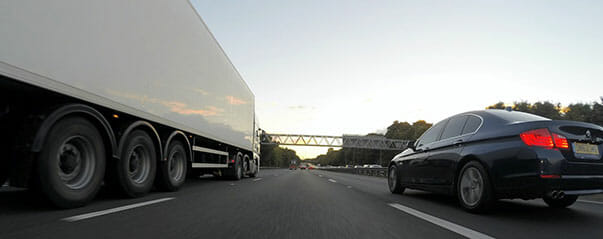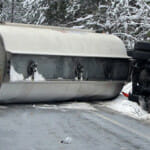
Truck Drivers Cannot See Your Vehicle If You Cannot See Them
March 2, 2022 / Truck Accidents
The number of large truck crashes has more than doubled since 2009, and commercial motor vehicle operators bear the lion’s share of responsibility.
It’s essential for everyday people to understand that professional truck drivers are tasked with heightened safety at all times on our roads and highways. They undergo Commercial Driver’s License (CDL) education and training to maintain control of rigs weighing upwards of 80,000 pounds, traveling at high speeds. However, the safety of you and your passengers requires keeping a safe distance and avoiding their blind spots whenever possible.
At Stephenson Rife, we see too many of our Indiana community members suffer sometimes avoidable injuries and significant losses. We hope this information about large truck accidents helps you and your family members travel more safely. If you or someone you know has been involved in such an incident, consulting an experienced truck accident lawyer in Indiana can be a crucial step in understanding your legal options.
Where Are Large Truck Blind Spots Located?
The Federal Motor Carrier Safety Administration (FMCSA) reports annual truck-involved accidents in Indiana to hover around 5,000 annually, with more than 1,500 serious injuries occurring and nearly 150 deaths. While there is a wide range of causes for these collisions, truckers know precisely where their blind spots are and possess the education in techniques to prevent impact with passenger vehicles and others. For your safety,consider staying out of these blind spot areas when in close proximity to big rigs. In unfortunate cases where an accident occurs, consulting a big rig accident lawyer can be crucial in understanding your legal rights and options.
- Directly in Front: It sounds counterintuitive to think a commercial motor vehicle operator cannot see a car or SUV directly ahead. The fact of the matter is that CDL holders often sit high above smaller automobiles. After factoring in how far back a trucker sits in proximity to the wheel and windshield, it’s easier to understand that objects directly in front are difficult to see.
- Angled to the Left: When traveling in the lane closest to the 18-wheeler, a line of sight is lost. This space exists from the side mirror and angles slightly back and to the left. If you don’t see the truck driver’s face in their mirror, they cannot see you either.
- Angled to the Right: The blind spot to the right tends to be larger than the one on the left. That’s primarily because a large vehicle operator will identify you with peripheral vision. The cab’s interior eliminates that possibility when you are passing or traveling to the right of a tractor-trailer.
- Rear Third of Trailer: It’s critical to avoid traveling alongside the back third to half of a trailer, container, or other loads. This area remains difficult for truckers to see, and you may notice that you cannot see their eyes in the side mirrors. This danger zone ranks among the more common places for impacts.
- Directly Behind: Sometimes, people talk about “drafting” a tractor-trailer. The idea is that the big rig creates an aerodynamic advantage that pulls smaller vehicles along and improves gas economy. It’s also a form of tailgating and very risky, because they cannot see you.
Paying close attention to where your car, truck, or SUV is positioned allows you to take measures to maximize roadway safety. But the main rule to remember when considering blind spots is that if you cannot see the trucker, that trucker probably doesn’t see you either.
Common Situations that Result in Truck-Involved Accidents
When traveling to work, running errands, or bringing children to activities, it’s worth remembering that a great many truck-involved accidents are partially the result of unforeseen circumstances. If you are safely driving your automobile when an unexpected event impacts a truck driver, you and your loved ones could be in harm’s way. These rank among the common ways collisions occur:
- Rollovers: Truckloads are not always evenly distributed inside the trailer. This may result from a company warehouse worker’s not exercising due diligence. But when a passenger car is next to the 18-wheeler as the load sways and causes a rollover, the result could prove catastrophic.
- Blowouts: The highways are littered with truck tire retreads. That’s an indicator that a blowout may have occurred. Perhaps the most dangerous place to be is in a blind spot when a CDL holder makes a fast lane change to get to the shoulder.
- Swinging Turns: Many large commercial trucks display caution signage about wide turns. When effecting a swing, truck drivers routinely lose sight of cars around them. Remain at a safe distance and give truckers a wide berth when making turns.
The rules of the road dictate that we must all practice diligent safety and maintain control over our motor vehicles. In these and many other scenarios, freight haulers are tasked with avoiding crashes and the sometimes catastrophic injuries that result. As an Indiana law firm that puts people first, we care more about working families than settling truck accident lawsuits. That’s why we hope these safety tips will make a difference.
Tips to Avoid Accidents with Trucks
When negotiating roads and highways shared with large trucks, there are some strategies that can reduce the possibility of collisions. Based on the idea of your seeing the truck driver and vice versa, consider employing these tips:
- Signal Early: When passing a commercial motor vehicle, people typically enter a blind spot. Consider using your directional light before accelerating. This lets the trucker know your intentions and alerts them that you may cross a blind spot.
- Two Car-Length Rule: When passing a semi, wait for a minimum of two car lengths of distance to be available before moving into the same lane. This strategy keeps you from entering a front blind spot.
Keep in mind that heavy-duty trucks traveling at high speeds may need upwards of 200 yards to come to a complete stop. The FMCSA indicates that even at speeds under 40 mph, semi-trucks usually need at least one second for every 10 feet in front of the vehicle.
The FMCSA reports that it saw a rise in drug and alcohol violations year-over-year after implementing its complete Clearinghouse testing initiative in 2020. More than 4,600 CDL holders tested positive for drugs, and a growing number refused to comply with the mandate. Add a wide range of trucker negligence to the mix, and passenger vehicle operators would be well-served to steer clear of an 18-wheeler’s blind spots. In light of these alarming statistics, anyone involved in an accident with a commercial vehicle should consider consulting a commercial vehicle accident lawyer to understand their rights and options.
Contact An Experienced Indiana Truck Accident Lawyer
The number of truck accidents remains unacceptable, and good people suffer too many injuries, fatalities, and losses. Professionals drivers are trained to know how to operate a fully loaded semi-truck safely at all times. When they fail in that duty, families are often devastated. If you or a loved one has been involved in an accident, our determined legal team will fight to get you the full, fair compensation you deserve. Call Stephenson Rife to schedule a free case evaluation at (317) 680-2350 today.

Attorney Mike Stephenson
Attorney Mike Stephenson has 40 years of experience and is a trusted advisor to many individuals and companies. His current practice is dominated by civil litigation in state and federal courts. He focuses much of his time on handling catastrophic injuries caused by all types of accidents, including motor vehicle, trucking, workplace injuries, product liability, just to name a few. Mike is a proven advocate and trial attorney. He has served as lead trial counsel in more than 100 civil jury trials, and has handled litigation in 18 states. [ Attorney Bio ]



